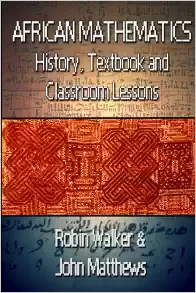African Mathematics: History, Textbook And Classroom Lessons
by Robin Walker
Nonfiction, Paperback, 182 pages
More Info ▶
Description of African Mathematics: History, Textbook And Classroom Lessons by Robin Walker
African Mathematics: History, Textbook and Study Guide aims to meet several objectives. Firstly, the book gives a historical overview of Africa and its contribution to Mathematics. Secondly, the book provides the teacher and the learner with study materials that can be used in the classroom. Thirdly, the book introduces some of the numerical patterns and puzzles that has fascinated one of the authors John Matthews. Fourthly, the book introduces the lectures, classes and workshops that the two authors teach on these subjects. Mathematics has an interesting history in Africa.
This history forms the first part of the book. The earliest known mathematical artifact in human history is the Lebombo Bone. Thought to be 37,000 years old, it was discovered by archaeologists in South Africa. Scholars believe that the number system carved into the bone represents a lunar calendar. Later mathematical evidence comes from the Ishango region of Central Africa, Ancient Egypt, Medieval North Africa, Ethiopia, Medieval West Africa and Medieval Central Africa.
Mathematics teachers have asked for material that can be used in the classroom where these African mathematical ideas can be used, tested or even challenged. To this aim, the second part of the book presents classroom material that can engage children. Each lesson demonstrates a mathematical principle followed by classroom exercises that the pupils can attempt. We have provided perhaps 22 hours worth of teaching and learning material.
The third part of this book was written wholly by John Matthews, a secondary school mathematics teacher. It contains a sample of his tips and short cuts that any pupil of mathematics can profitably use to improve their engagement with number. Mr. Matthews also believes that students of mathematics should enjoy detecting patterns in number sequences. In the fourth part of the book he presents a sample of his own discoveries in this area. He also presents classroom exercises that the pupils can attempt.

Additional Book Information:
- ISBN: 9781500667399
- Imprint: CreateSpace
- Publisher: On-Demand Publishing LLC
- Parent Company: Amazon.com, Inc.
